9. Textile Scaffold¶
INDEX IMAGE ~ Alum crystal structure: octahedral when from a neutral solution and cubic if the solution is alkaline.
Research and Lecture¶
This week we are focusing on the intersection of textiles and industry / technicality. We are covering a wide range of topics mostly centering around interfaces (relationship of textile and another surface) and composites (multi-material syntheses). We are studying mold making (specifically with leather), mycelium, crystallization, casting in fabric forms and making biocomposites. We will learn about CNC milling and working with the vacuum former in the lab.

Ideas to consider:
- What designed structural or material properties in materials can benefit the wearer or surrounding environment?
- How may textiles and textile technology be a useful tool in other industries such as architecture, engineering, product design etc?
- What waste streams can act as resources for bio-composites?
- How can we design in a post-human way, in consideration for other organisms or inviting other organisms to contribute to the design process (ethically)?
Intro to Composites¶
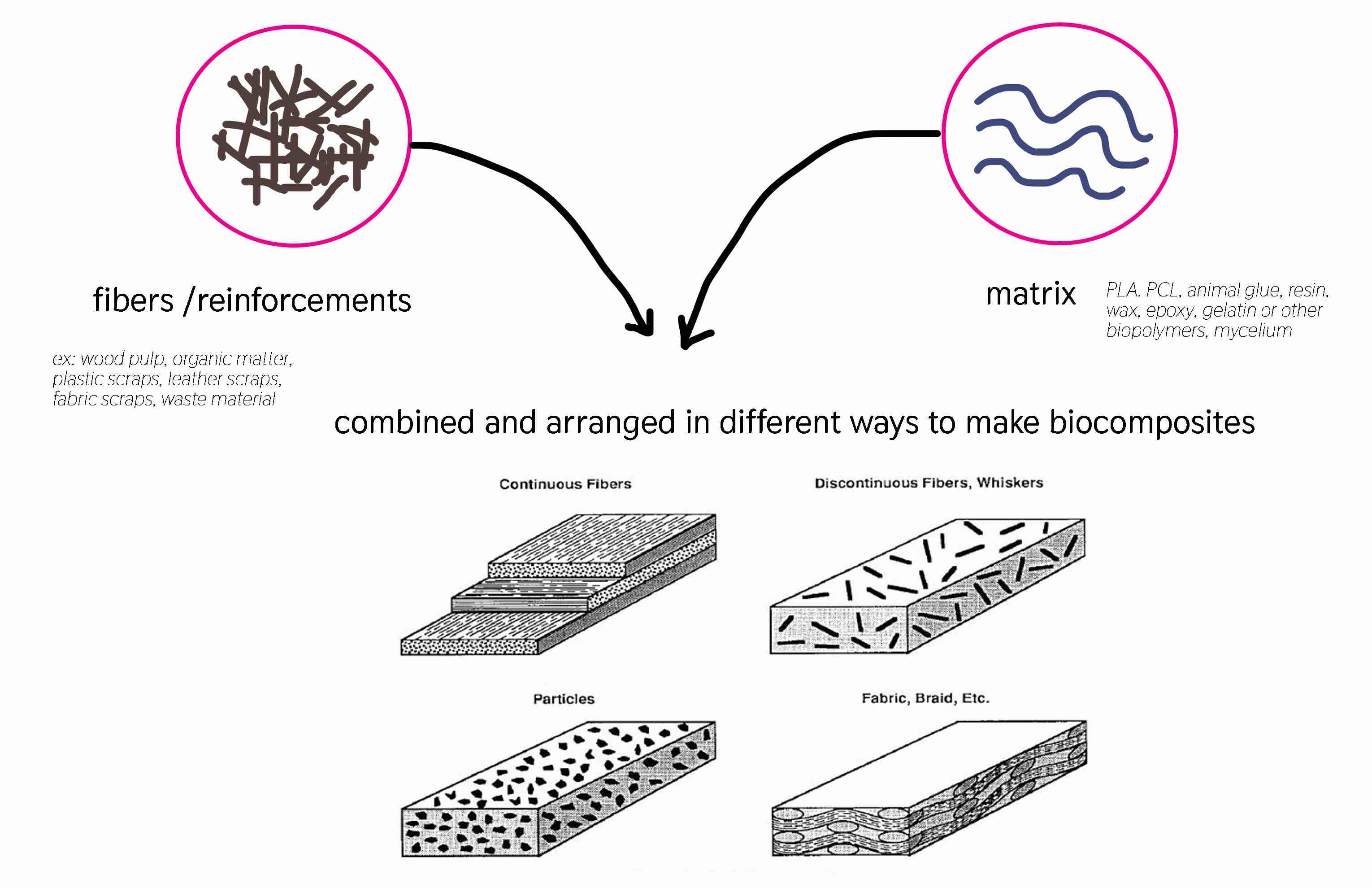
Local Tours¶
We started the week by visiting a few studios around Barcelona.
At Footwearology we learned more about 3d printed footwear and knitting machine technology. One comment I found important is that there are no biofabricted yarns available to work with on the knitting machine. The machine is very sensitive and needs a filament (non fiber) strong yarn to function. This demands for innovation!
 Then we saw modern leather accesory show room and studio, Madre. It was great to hear about their small buisness structure and see their low waste, oragami style designs.
Then Norman Vilalta made an interesting comment in his bespoke shoe workshop - he believes craftsmanship does not have to mean hand working, it's more about knowledge, experience and love. Making through technology and machines can be beautiful craftsmanship as well.
Then we saw modern leather accesory show room and studio, Madre. It was great to hear about their small buisness structure and see their low waste, oragami style designs.
Then Norman Vilalta made an interesting comment in his bespoke shoe workshop - he believes craftsmanship does not have to mean hand working, it's more about knowledge, experience and love. Making through technology and machines can be beautiful craftsmanship as well.
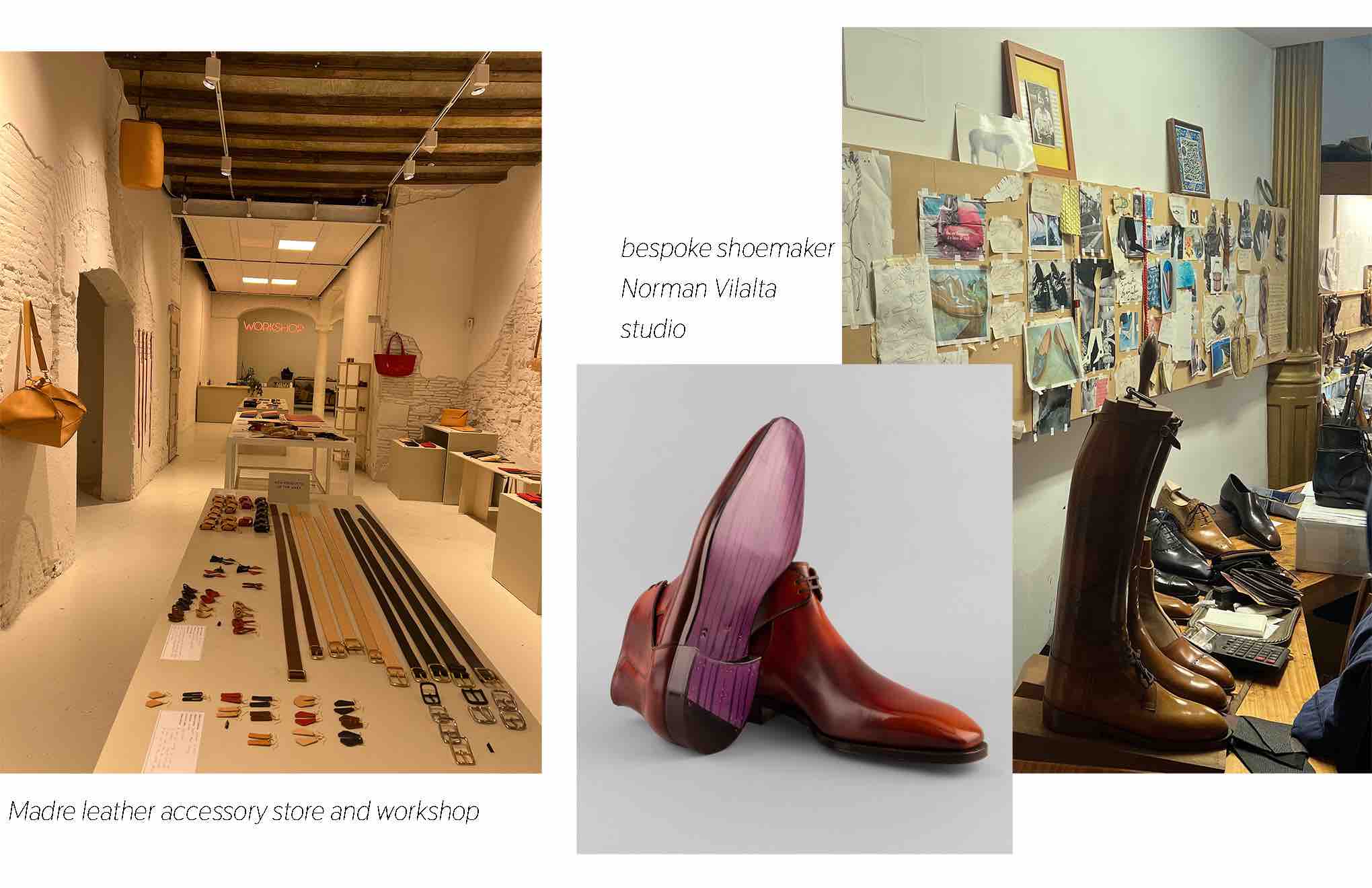 We also had the incredible experience of touring the lab and workspace of Jess Diaz and Lara Campos. Some past projects by biobabes were on display. We learned more about molding and plating mycelium from Jess's workshop and heard about her new venture to create a mycelium-based surfboard.
We also had the incredible experience of touring the lab and workspace of Jess Diaz and Lara Campos. Some past projects by biobabes were on display. We learned more about molding and plating mycelium from Jess's workshop and heard about her new venture to create a mycelium-based surfboard.

 I also learned some good tips for continuing with my mycelium mannequin:
I also learned some good tips for continuing with my mycelium mannequin:
- With bulk substrate pasteurize it, not sterilize (boiling or steam 70-80 C for an hour)
- Amount of water concentrate in substrate is important (want a 70% humidity) (test by squeeing substrate and make sure no drips)
- If you want to create mushroom growth in the mycelium object, put it in a container with the lid slightly cracked and spray with water once a day.
References & Inspiration¶
Paper Wasp Biocomposite¶
While usually treated as a nuisance or even a danger, paper wasp’s nest is a stunning example of a natural biocomposite! Each spring, the fertile female queen wasps that have been hiding all winter emerge, searching for new nest sites. The queens usually work as a team until one arises as the most dominant and the rest are subjected to worker roles. The wasps gather weathered wood (fibers/reinforcements) in their environment and chew this fiber with their saliva (matrix) into a sticky pulp. Their saliva is water-proof, resulting in strong, water repellent nests. They form the pulp into hexagonal shells to hold their eggs. Each nest lasts about a year as it usually starts to degrade through the winter, so the next spring the process repeats. (source) (source)


Biologist, Mattia Menchetti, had the idea to facilitate this biocomposite construction by providing colored construction paper for the wasps in a controlled setting. In this experiment you can clearly see the design tendencies of the wasp in patches of color.

Talk by Ron Wakkary¶
I also got to hear a lecture by Ron Wakkary about his work studying other-than-human centered design. It was interesting to hear about his de-familiarizing and counter-factual objects (items that make us break routine thought and action patterns) and how these can help us rethink limited human-centered mindsets. He suggests considering these factors when designing: 1. the life force at work 2. what it will inscribe in the world 3. what it leaves behind. He also mentioned Donna Haraway's thoughts on being cyborg. He explains all of our clothing and personal items change our being, and therefore are not compelely seperate. It made me think about how textile technology can enhance our interaction with the environment and connection with other people and other species.
 Also was interesting hearing Josep explain how we should listen carefully to machinery such as the CNC machine beause it will react to issues like wrong speed times by screeching or groaning like a baby would. Being sensitive to the animate nature of things usually considered nonanimate really changes the design process and designs themselves. Fabricating with a machine is inviting another entity into the process. Although maybe computed and "controlled" by us, there are still ways machinery leaves it's mark on designs and factors that may be unexpected.
Also was interesting hearing Josep explain how we should listen carefully to machinery such as the CNC machine beause it will react to issues like wrong speed times by screeching or groaning like a baby would. Being sensitive to the animate nature of things usually considered nonanimate really changes the design process and designs themselves. Fabricating with a machine is inviting another entity into the process. Although maybe computed and "controlled" by us, there are still ways machinery leaves it's mark on designs and factors that may be unexpected.
Books¶
CNC Notes¶
Tool Heads:
There are different tools that depend on the material you are using and detail level you need. There are flat nose nozzle vs ball nose nozzle, ball nose are better for organic curves and flat is better for sharp corners. The diameter of the tool affects the detail level. Each tool aslo has a certain number of flutes (the spiral that twists around the tool).

Upcut: when the flute (spiral) will wrap the material up
Downcut: when the flute (spiral) will take the material downwards
Basic Steps:
- Change the tool to the one you need
- Use two wrenches to twist the gear to remove the tool
- Take out the gear to change the inner holder (push it on the side)
- Click the new one into place
- Make sure it is clean ( use air pressure tool to clean it)
- Screw in supports to hold the whole block of material
- Find origin using the controls on computer screen or remote (put a bit inside the material block to make sure it won’t go off the edge)
- Use button under the tool to measure the Z axis or do it manually
- Put on safely glasses and stand away from the machine
- Run the rough cut
- Run the finishing cut
- Cut out the shape completely
- Remove the block of material when done
- Clean with vacuum
TIPS
- Working with plastic- get chips out of the way cause they can cause friction and melt
- Working with plywood - upcut tool will create a rough edge because it will disrupt the wood layers
- Foam is low risk and it can be sanded to have a smoother finish
- To make the female part is a bit bigger change settings in the parameters - so the other part can fit inside it
Process and Workflow¶
Crystal Experiments¶
A crystal or crystalline solid is a solid material whose constituents are arranged in a highly ordered microscopic structure, forming a crystal lattice that extends in all directions.
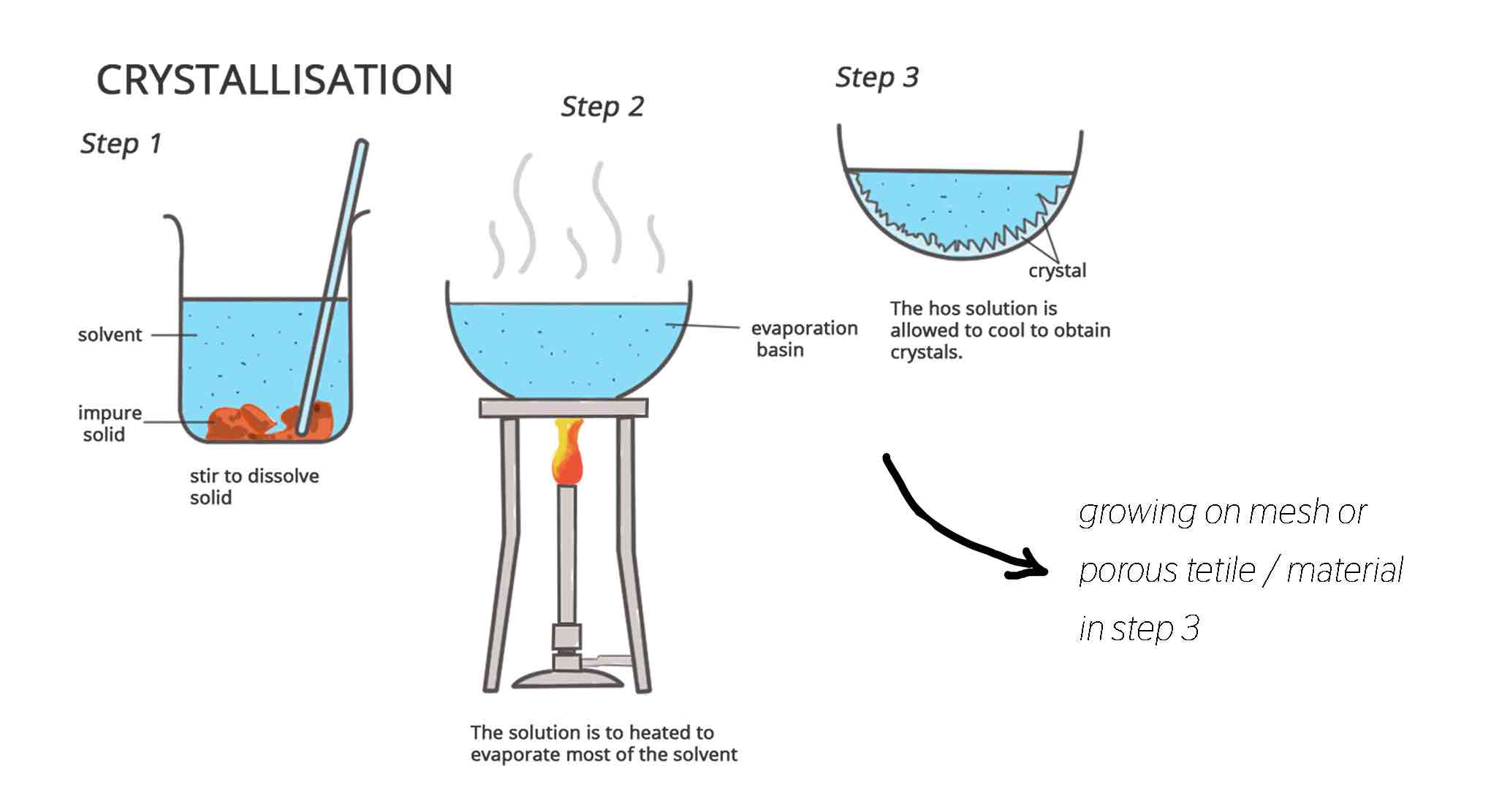

Alum Crystals
* 60g alum
* 500ml water
- stovetop
- thermometer
- glassware and mixing tool
- alluminum foil or fabric
- coffee filter
* Measure out your ingredients
* Heat the water to just before boiling (close to 80 or 90 C)
* Mix in the mineral, stirring as you go so it dissolves completely
* Add in any other additives to the solution
* Strain the solution using a coffee filter
* Pour it into a container and suspend your fabric or material in the solution (keeping space from the bottom and sides of the jar)
* Cover the container with alluminum foil or fabric to keep the heat from excaping too quickly.
* Wait for crystals to grow
Borax Crystals
* 150g borax
* 400ml water
- stovetop
- thermometer
- glassware and mixing tool
- alluminum foil or fabric
- coffee filter
* Measure out your ingredients
* Heat the water to just before boiling (close to 80 or 90 C)
* Mix in the mineral, stirring as you go so it dissolves completely
* Add in any other additives to the solution
* Strain the solution using a coffee filter
* Pour it into a container and suspend your fabric or material in the solution (keeping space from the bottom and sides of the jar)
* Cover the container with alluminum foil or fabric to keep the heat from excaping too quickly.
* Wait for crystals to grow
Conductive Crystal Lace¶
I wanted to attempt to make conductive crystals using charcoal in order to experiment more with my playtronica (see bottom of week 8). I found a piece of lace at the flea market and sewed on a few alum seed crystals. I ended up using a borax solution so this may cause spikey crystals like Petra's experiment last year. I added about 25g of charcoal powder. I did not strain the solution before adding to the bin because it is hard to work at a larger scale and still be able to strain without the mixture coooling too fast.


 RESULTS
RESULTS
The borax crystals grew in a very thick layer around all of the textile that was submerged in the solution. The charcoal stuck to edges of some crystals giving them a black color (especially the crystals that were tocuhing the bottom of the container) and stained the textile grey in some parts as well. I tested the charcoal crystals for conductivity but they did not work :( I think the charcoal needs to be more evently dispered through the crystal to be conductive.



Naturally Dyed Crystals¶
I set up two more crystal experiments using more second hand lace samples and natural dye pigments from biochromes week. I sprinked a bit of the pigment into the solution before the filtering step.

 RESULTS
RESULTS
These did not work out too well. There are very few small alum crystals attached to the fabric. Mostly the solution left an interesting color pattern (which gives me the idea for using natural dye crystal baths for making patterns on mordanted silk or something). The cabbage pigment didn't even really leave a color. This could have been an issue of temperature (cooling too fast) or maybe the iron in the cabbage pigment interefered with the crystalization?


Crystalizing Organic Matter¶
Emma was kind to bring a few bones and dead things to experiment with crystals. We have an animal bone, a few animal teeth and 3 moth bodies. We set up borax solution glasses for all of those pieces and added cohineal pigment in the animal bone one.

 RESULTS
RESULTS
This is a nice method for making creepy or gross-seeming items into a beautiful and etherial scupture. The borax crystals stuc very well to the organic matter. We struggled with the moths because they were floating on the top of the solutio, they also got a bit soggy so they probabaly will start to biodegrade soon.



Results¶
| Photo | Material | Mineral | Additives |
|---|---|---|---|
 |
second hand lace | borax | charcoal |
 |
second hand lace | alum | cabbage + iron pigment |
 |
second hand lace | alum | cochineal pigment |
 |
animal bone | borax | cochineal pigment |
 |
animal teeth | borax | x |
 |
dead moth | borax | x |
Ammonite CNC Mold Leather Molding¶
Concept¶
For making a cnc mold and working with leather/composites I was inspired by rocks with fossil impressions. I love the spiral shell design and imagined a bag or accesory with an ammonite impression like these photos.

Rhino Modeling¶
I started modeling the shell in Rhino following advice from this post with these steps:
- Use Spiral to make a flat spiral with about 2.5 or 3 revolutions
- Edit singular points on the curve to give it more of an organic shape
- Pipe the spiral with circle radius on either end big enough that the sides of the pipe touch eachother in the spiral. The radius on the end will be bigger than the one in the center
- Make a Bounding box around the spiral and Apply planner mapping to the top rectangular face
- Take a screenshot of the shape and in photoshop, edit a jpg of a shell to match the shape of your model perfectly.
- Crop the photo to the edges of the shell and import it as a texture option in the Displacement tab

But then making this into a mesh I was recommended that the displacement texture will not transfer well and with enough detail to be CNC milled. So then I went looking for a pre existing model and lucky found a ton of cool options on Sketchfab. I did not know that were were so many free downloadable models on that site so that was great to learn. And even though I did not use my handmade model I am glad I learned more about displacent textures in Rhino. I went forward using this model as a mesh in Rhino and prepared the file for RhinoCAM
- Make a Bounding box on the mesh and then make a rectangle of the top plane of the box to represent the surface of the material.
- Offset 1cm on all sides to make more space around the model
- Extrude this rectangle into a box and move it lower in z direction to cover part of the shell as if it was emergind from rock.
- Make a Bounding box around the spiral and Apply planner mapping to the top rectangular face
- Make that box a mesh and join it with the shell
 I decided to make a small scale mold (about 100mm) and a larger scale one (about 200mm) to see how the resolution would be for both.
I decided to make a small scale mold (about 100mm) and a larger scale one (about 200mm) to see how the resolution would be for both.
RhinoCAM¶
Then working with the file in RhinoCAM I set parameters specific to my job:
- Set the stock to 0
- Changed the step over distance to 15 instead of 25, for more detail
- Set speed to 18000
I used the same parameters for the rough cut as the finishing cut. Then I made a final opperation to cut fully around the two shapes so they can come out of the material:
- Go to 2 1/2 profiling
- Select both rectangles round the shapes
- The thickness of the foam material is 100mm so you want to cut that deep
- Use bridge to keep it attached in a small section (you dont want a complete cut that causes the block to fly up into the machine)

CNC Milling¶
MATERIAL DETAILS


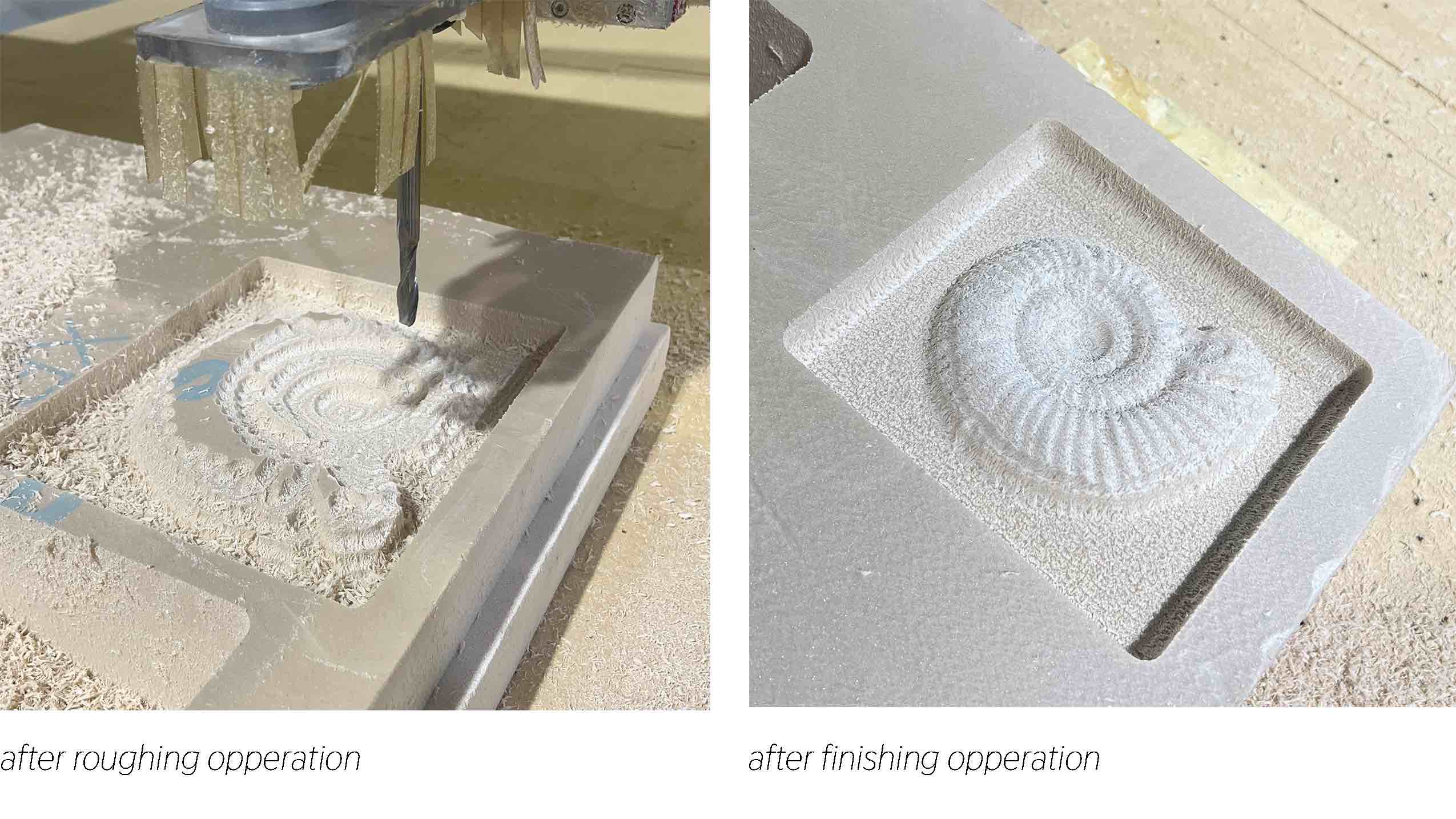

Leather Molding¶
I used some leather scraps left over at the lab with the cnc mold. We used a warm and wet tecnique where we soaked the leather for 30mins to an hour. Then brought water to about 80C with 4 spoons of baking soda and added the leather in for a few minutes. I covered the mold in plastic wrap, then the leather, then wrapped the whole thing in another plastic sheet.
* It is important to wrap and tape the whole thing very well to make sure no liquid leaks out into the vacuum machine.
I held my mold in the vacuum sealer for about 4 hours and then unwrapped it, used the heat gun on it and let it dry overnight.

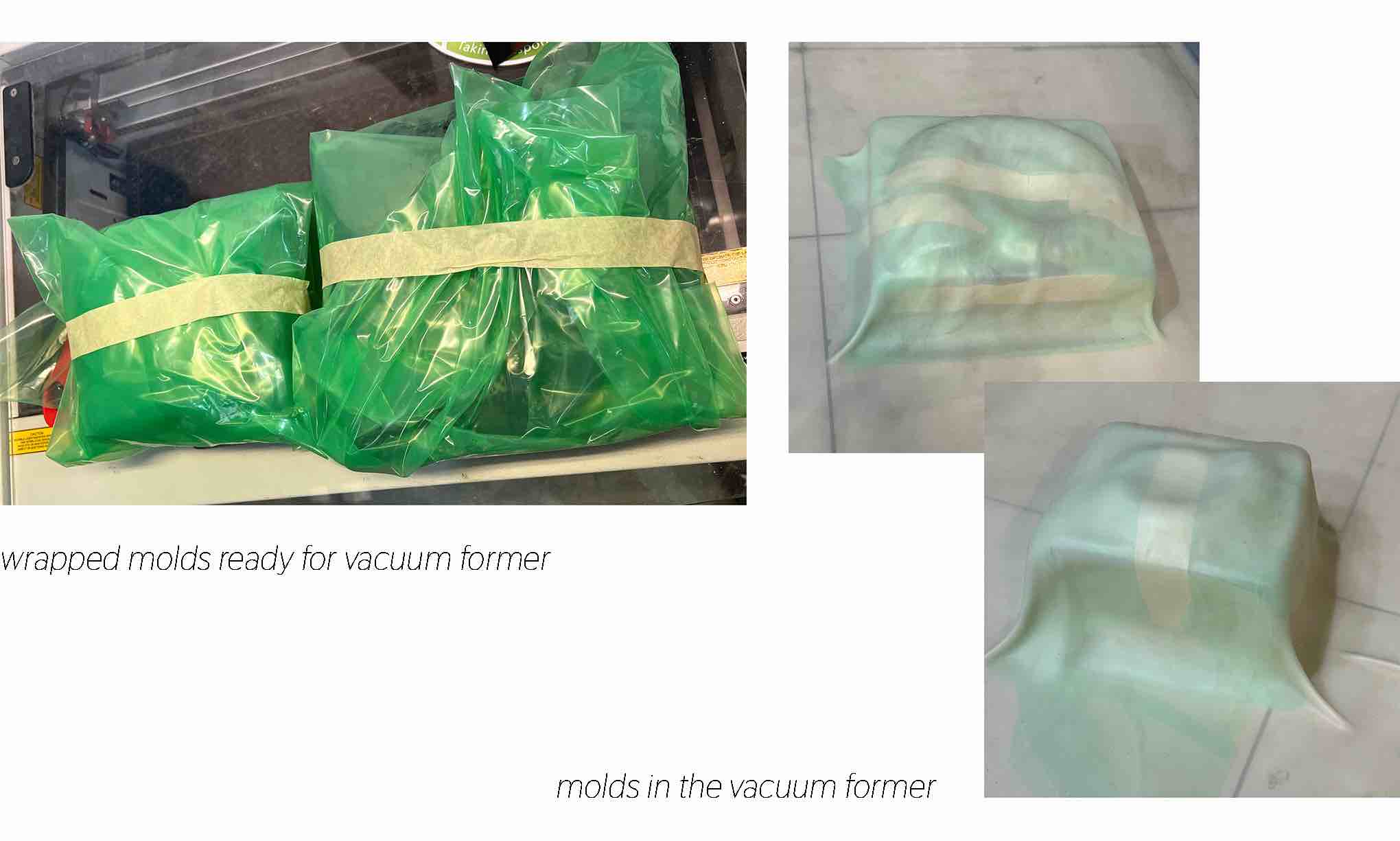
 RESULTS
The molds came out pretty well, but not with that much detail. It would definitly help if I had an inverse mold to make the divits more defined. I bought a PETG plastic sheet to thermomold to make an inverse mold and I will maybe try again next week. It would also help to use a thinner, stretchier piece of leather. The leather on the small mold was quite firm and did not take the shape very well.
RESULTS
The molds came out pretty well, but not with that much detail. It would definitly help if I had an inverse mold to make the divits more defined. I bought a PETG plastic sheet to thermomold to make an inverse mold and I will maybe try again next week. It would also help to use a thinner, stretchier piece of leather. The leather on the small mold was quite firm and did not take the shape very well.
Also I would like to make a sample with a lighter color leather to make it look more like stone, and to see the ridges more clearly.

Next Steps¶
- thermo forming PETG sheet over ammonite mold to make an inverse mold
- creating biocomposites with the ammonite mold and another leather attempt
- try more natural dye crystals maybe with borax and experiment with making color patterns on fabric through crystalization
- try crystalizing blood like Cristina Dezi
- use Loes Bogers documentation to retry conductive crystals